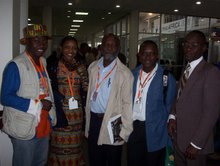ICT revolution at Suame Magazine

There is a sudden upsurge of interest among the otherwise low literate artisans of Suame Magazine for Information and Communications Technology (ICT) education.
What inspired this new spirit of ICT enterprise among the artisans appears a complete mystery to those familiar with the Suame Magazine environment where computer is largely considered the preserve of the formal sector.
The interesting point about these massive developments in the ICT at Suame Magazine is the exclusive private initiative of the Suame Magazine Industrial Development Organisation (SMIDO).
The Suame Magazine Industrial Development Organisation (SMIDO), the development unit and umbrella organisation of Suame Magazine has unleashed a revolution unprecedented in the informal sector industry of the country in Suame Magazine.
According to SMIDO, this new development is emerging as a response to findings from a survey in 2007 that indicated that less than one percent of the over 200,000 artisans at the suame magazine have email addresses and uses the Internet.
This was said to be at odds with the global orientation of their industrial operations requiring transactions with stakeholders across the world.
It was an exciting sight when the Daily Graphic visited the training centre last week to witness at first hand, how the artisans were acquiring computer knowledge.
The artisans in their usual fitting costumes were spotted busily going through lessons in ICT in a typical school-styled fashion.
I was confronted with a reality I never thought would happen at Suame Magazine’s largely independent artisanal population.
Artisans who have never sat behind the computer in their lifetime are now manipulating the computer for various designs that would leave the average visitor to the resource center pondering over whether he or she was really at Suame Magazine.
The center has four instructors with two expatriates from the Columbia University in New York.
Records at the resource center indicated that high profiled personalities like Dr Kwabena Duffour, Professor Kwabena Frimpong Boateng, the KMA Chief Executive, Ms Patricia Appiagyei, Ms Dorothy Gordon of the Ghana Indian Centre of Excellence in ICT, Professor Vasco of the Institute of Advanced ICT Studies and a host of other dignitaries have visited the resource center to acquaint themselves with this new revelation at Suame Magazine being spearheaded by SMIDO.
The President of SMIDO described this as not necessarily an ICT revolution but a mindset to embrace the modern world of technology, which is threatening the survival of Suame Magazine and the artisanal engineering industry in Ghana.
In an interview, Mr Nyaaba-Aweeba Azongo, consultant to SMIDO revealed that plans were underway to establish an Internet café to introduce the artisans to the use of the Internet given the advances they have made at the basic stages of computing
According to Mr Azongo, the Ghana-Indian Kofi Annan ICT Center is rolling out a programme with SMIDO to introduce an artisanal engineering model of International Computer Driving License (ICDL) to offer international certification to artisans upon graduation at the resource centre.
He contended that the ICT breakthrough is an important milestone towards graduating the artisans of Suame Magazine towards the modern industrial village to be established by SMIDO on a 1000acre land at Asenemaso in the Atwima Nwabiagya District of Ashanti.
According to him, the full potential of ICT to economic development is seen as the creative sectors of the economy and said that these are the sectors that have been left behind in the nation’s planning process.
He said the formal sector was not a force to reckon with in the creative industry where ICT could introduce the magic wand for economic development.
In his elaboration, the main determinant of the creative economy is the proportion of the employment and entrepreneurial seeking ratios of the labour population.
He contended that the formal sector has a preponderance of employment seeking attitudes as against the entrepreneurial seeking behaviours of the average workforce in the artisanal or the informal Sector.
In this direction the entrepreneurial creative industrial sectors incorporation of ICT is a key instrument towards wealth creation and sustainable development.
For his part, the President of SMIDO, Mr George Asamoah Amankwa expressed the hope that the government would extend a vehicular support to SMIDO project, which was a major undertaking worthy of national commitment and support.
In another development, a team of experts from IBM, the global computer giants would be arriving in Ghana by the end of September 2008 for a one month assignment with SMIDO to support the review and curricula development of the Suame Tech Automatics Engineering Institute for ICT in vehicular diagnosis and repairs.
This is to set the basis for a formal training center for artisans in Suame Magazine and the rest of the country. 





















No comments:
Post a Comment